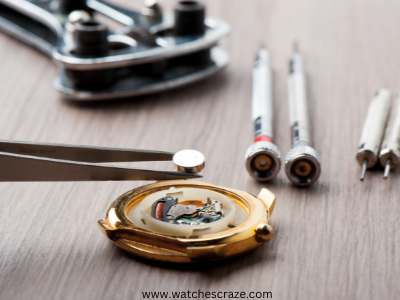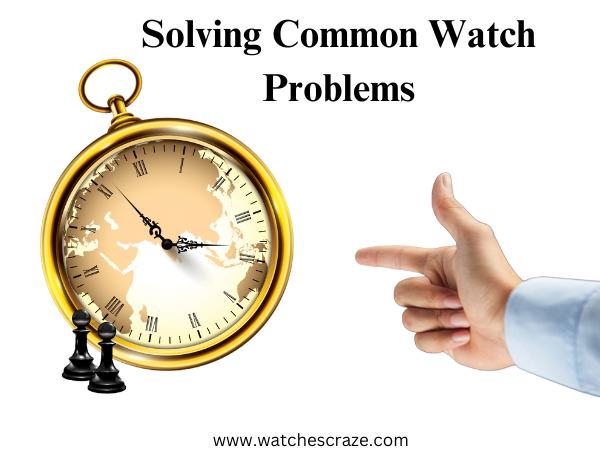Solving Common Watch Problems: Troubleshooting Tips Every Owner Should Know
It is highly essential to maintain the condition of your watch. More than just telling time, it means taking care of something valuable. They all need some occasional TLC, be it a conventional mechanical one or a contemporary digital piece. In this article, we will discuss the importance of looking after your watch and common problems faced by owners of watches. So without further ado let us find out how to keep these timekeepers ticking smoothly!
Identifying Watch Problems

It can be not very pleasant when your wristwatch does not function properly. However, do not panic because below are some tips on how to know if something is amiss:
Here are some Signs that tell us a Watch Is Broken
01. Stopped or Slow Movement:
If the tick-tock stops completely or slows down beyond usual, there is an issue.
2. Inaccurate Keeping Of Time:
You should take action when you realize that your clock always gains or loses minutes consistently.
3. Weird Noises:
Internal faults may be indicated by abnormal ticking sounds, grinding, or clicking noises emanating from the watch.
4. Foggy Face Or Moisture:
The mist inside the dial points out the presence of water which causes damage if left unattended too early enough.
How to Determine the Root Cause of a Problem

-
Battery Check:
If your watch utilizes quartz movement and suddenly stops, the battery could be dead. Try replacing it to see if that fixes the problem.
-
Movement Inspection:
On a mechanical or automatic watch, look at the gears and springs for visible debris or damage.
-
Water Resistance Assessment:
When moisture has gotten into a watch, drying it out and servicing may be necessary to avoid further harm.
-
Crystal Examination:
Scratches or cracks on the watch crystal can affect performance; check closely for any repairs needed.
A Practical Guide to Solving Common Watch Problems

Sometimes our trusty timepieces hit a snag or two, but don’t worry! Here are some of the most common problems along with their solutions:
1. Battery Replacement
Ever seen your watch lose its usual pep? If it’s running late or has stopped entirely, chances are that the battery is dying.
Step-by-Step Guide to Replacing a Watch Battery
You’d be surprised how easy it is to swap out a watch battery! All you need is a small screwdriver – pop off the back, gently pry out the old one with it, and slot in a shiny new replacement.
2. Water Damage
Uh-oh, did your watch take an unexpected dip in the pool? If you spot foggy condensation under the crystal or notice the dial looking a bit murky, your watch might have taken on water.
Steps to Salvage a Water-Damaged Watch
Don’t panic! Immediately remove your watch from the water, dry it off gently, and let it air out completely. Then, take it to a professional who can open it up, clean out any moisture, and get it ticking again.
3. Broken or Scratched Crystal
If your watch crystal has seen better days with scratches or cracks, it can affect both its appearance and functionality.
Options for Repair or Replacement
Depending on the extent of the damage, you might be able to buff out minor scratches yourself. For more serious issues, it’s best to consult a watchmaker who can either repair the crystal or replace it with a fresh one.
4. Stuck or Jammed Crown
Are you struggling to wind your watch or adjust the time? One common culprit is a stuck crown, typically caused by dirt, dust, or a lack of lubrication.
How to Free a Stuck Crown
Try giving your watch a gentle tap or wiggling the crown back and forth. If it continues to stick, it may need professional attention involving disassembling and cleaning the crown mechanism.
5. Watch Keeps Losing Time
Does your watch always run a few minutes fast or slow? Magnetization, shock, or simply needing an adjustment could be to blame.
How to Adjust and Regulate Your Watch
If your watch has lost track of time, try tweaking the regulation screws or having it professionally regulated. Sometimes a small calibration can make all the difference!
6. Loose/Broken Strap
Is your watch strap looking worse for wear? When it starts fraying, cracking, or feeling loose on your wrist – it’s probably ready for retirement.
Replacing Your Watch Strap
Whether you choose to do it yourself with online tutorials or visit a local jeweler/watch shop – swapping out an old/worn strap is an easy way to breathe new life into your favorite timepiece!
7. Foggy Dial or Condensation
If your timepiece feels a little bit hazy on the inside, chances are that humidity has found its way into the case – a common occurrence following contact with water.
Measures for Getting Rid of Moisture Inside a Watch
To clear off this fog, take the watch to somewhere dry and warm then let it dry completely. If condensation continues to be present, it would be best if an expert opened up the case, dried it out, and ensured there was no permanent damage done.
With these tips and tricks in mind, you will become an expert in solving problems related to watches within no time!
FAQs
How to fix a watch not working?
1st of all check if its battery is properly seated or not then consult a professional watch repair service.
What stops a watch from working?
Many reasons stop a watch from working but the main reason is its battery.
Why do mechanical watches stop working?
They mainly stop due to issue like insufficient winding.




